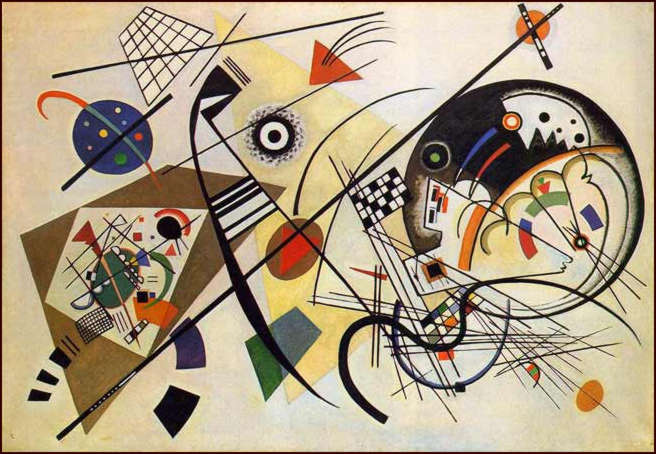
Wassily Kandinsky. Several Circles. 1926. Oil on canvas. 140 x 140 cm. The Solomon R. Guggebheim Museum, New York, NY, USA.
Circe circle, dot dot. This is what Kandinsky‘s…not. While this particular rap lyric is true to the shapes that the Russian artist would explore later on in his career, those circles can’t be summarized in so many words. No, the circumference of each round shape was deliberate, its placement on the canvas was planned and the color transparency was carefully pondered by Wassily. He started from a point – a desire to raise art to the level of music – and expanded it outward, into a whorl of tints, tones and thrilling compositions. Perhaps, Euclid’s definition of a point could be applied to Kandinsky’s beginning: “A point is that which has no part.” Kandinsky took that bottomless point and gave it a part while setting it apart – the point became a site for the compass tip, from which the circle could be drawn.
Kandinsky was, after all, a man of measurement. People will often exclaim that the artist’s strokes seem random; his shapes, absurd; his subject, inscrutable. Yet there is a calculated dignity to Kandinsky’s paintings, a precision to the process of his art. Throughout his career, Kandinsky explored the triangle ( too stable), the square (too peaceful) and the circle, finally granted superior status as a symbol of renewal, continuity. Pencil marks noted the color-to-be in canvas corners- small inscription of “RT” for “rot” (red) and “W” for “weiss” (white). An amusing transition from Russophilia to expressionism to abstraction to Bauhaus geometry and finally, the muted palette of an older man in Paris experiencing a lighter, subtle spiritual regeneration while the world around him buzzes with chaos.
Kandinsky’s development is displayed beautifully throughout the Guggenheim, exhibited in a chronological manner with informational blurbs to aid the viewer. At the very bottom, one can glimpse Kandinsky’s affection for pre-Peter Russia: old dames in headdresses and young girls with thick, muted blond braids, everything in matte jewel-like colors like light shooting through layered tempera. Further up the Guggenheim slope, Kandinsky’s art turns to organic sources: paintings that resemble cell diagrams emerge, thin fish-bone lines appear in the corners, and landscapes become blocks of different tones placed side by side. In the earlier paintings, at least, some objects are distinct- this is the sky, there the wheat swaying, and out yonder the farmhouse with a visible roof. But suddenly, the nausea kicks in. Shortly after seeing Monet’s haystacks and hearing Wagner’s music, Kandinsky realized that the dizzying discomfort in his art lay in its inability to portray emotion properly. With this revelation came the gradual development of an ultimate mission in art: to reach the ideal of music, to express the timbre of feelings through brushwork. In this vein, Kandinsky categorized his work into three musically-inspired groups – Impressions, Improvisations and Compositions – defined by the amount of deliberation and structure within each painting. Kandinsky chose to paint emotions in an abstract manner, and the struggle to refine and understand them pictorially would occupy the rest of his career.

The collection of Kandinsky’s work at the Guggenheim seem naturals for the architecture of the museum. The spiral, perhaps, is a shape the audience can relate to most when viewing Kandinsky. To Kandinsky, life may have seemed a circle – a cycle continuous and present, bearing within its circumference the sum total of his emotions transcribed onto canvas. But the contemporary observer must eventually see Kandinsky as a finite spiral, a curl upon art history. The trick here is to look past the shapely objects and discover the Kandinsky moment, where art jumped into music and color found sound.
View the Guggenheim Museum’s online Kandinksy exhibition here.
Comments
Leave A Comment